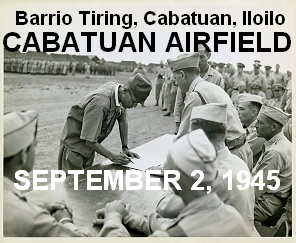
Col. Tozuka signs the surrender instrument
as Col. Stanton looks on, in Cabatuan Airfield,
Barrio Tiring, Cabatuan, Iloilo,
September 2, 1945,
Panay Island, Philippines
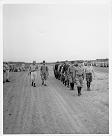
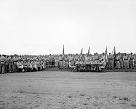
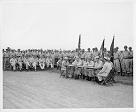
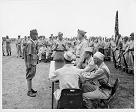
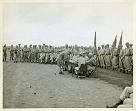
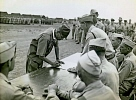
More about Lt. Kumai
A Soldier's Responsibility (Photos)
Kumai's Story (www.kumaibuki.com)
Chapters of Blood and Mud in the Philippines mentioning "Cabatuan Airfield":
Chapter 7,
Chapter 8,
Chapter 10,
Chapter 11
The Blood and Mud in Philippines, Anti-guerilla Warfare on Panay Island;
Toshimi Kumai, author;
Yukako Ibuki, translator;
Ma. Luisa Mabunay, editor;
Ricardo T. Jose, editor
|
Planes from the US Navy aircraft carrier USS Essex attack Cabatuan Airfield
AIRCRAFT CARRIER USS ESSEX STRIKES CABATUAN AIRFIELD
ON SEPTEMBER 14, 1944
© RMC / , 2016
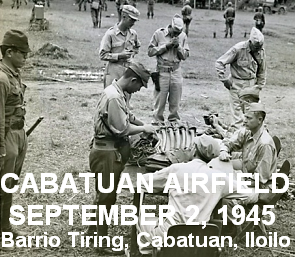
Japanese officers being processed at
Cabatuan Airfield,
Barrio Tiring, Cabatuan, Iloilo,
Panay Island, Philippines
|
|
June 8, 2016
After striking Mindanao on September 9 to 10, 1944, the U.S. Navy Task Groups 38.1, 38.2 and 38.3 refueled in an area south west of Palau.
The original plans had called for continued strikes against Mindanao on September 12 to 14, 1944, but since the assigned targets in that area had been destroyed, the order was changed and plans were made to attack the Visayan Islands.
On September 14, 1944, Task Group 38.2 was zigzag-ing in the high seas east of Samar when the strikes against Cabatuan Airfield were launched from the aircraft carrier USS Essex.
The first wave was a fighter sweep, led by the U.S. Navy top dog, Capt. David McCampbell, the top ace of American naval aviation, with the highest number of 34 downed Japanese planes to his credit.
The fighter sweep was composed of 10 fighter planes. Five strafing passes were made on at least 25 to 30 Japanese planes caught on the ground. There were planes that burned.
The second wave was led by Lieut Commander Rigg, and was composed of 8 fighters, 8 bombers and 7 torpedo bombers. The fighters went down first, strafing the rest of the Japanese planes on the ground that were not burning from McCampbell's earlier attack. The bombers then bombed the barracks and the shops around the airfield.
The third wave was composed of 10 fighters, 9 bombers and 5 torpedo bombers, but the targets were now extremely skimpy.
The battle damage report indicated that the barracks, as well as 6 shop buildings, were destroyed at Cabatuan Airfield.
- o -
The attack on Cabatuan Airfield on September 14, 1944 was mentioned by Cabatuan historian Ciriaco Morales in his timeline:
Sept. 14, 1944 - Bombardio al Landing Field de Tiring, Cabatuan, Iloilo, por las fuerzas aereas de la armada americana y destruyeron mas de 30 earoplanos japoneses. (Cabatuan, History of a Town and her People, Cabatuan Historical Society, 1977)
(Sept. 14, 1944 - Bombing of Tiring Landing Field, Cabatuan, Iloilo by the air forces of the American armada, destroying more than 30 Japanese planes)
- o -
Cesario Golez, one of the deputy governors of Iloilo Governor Thomas Confesor, was high up in the mountains on that day:
"We were on the summit of a high hill. the mountains of Dingle, and Dumangas, and Barotac Viejo, and Sara, were no bigger than small mounds of earth from our lofty perch. The City of Iloilo was a white pancake in the distance to the east of us. The strait separating Panay and Negros looked like a thin stream of sticky milk. The whole scenery seemed to be silent and desolate. Silent were the birds in the nearby bushes."
(Calvary of Resistance: The Price of Liberty, Cesario Golez, page 173)
Suddenly, the silence of the scenery was broken by sounds of planes:
"Then the solitude suddenly became alive with the droning sound of machines, which was sharply unlike the familiar, hoarse, guttural sputterings of the japanese planes. We directed our eyes towards the city of Iloilo and the Tiring Landing Field at Cabatuan. Presently, we saw planes nose-diving. We thought for a moment they were japanese planes staging an aerial practice. Some of us even expressed a wish that the infernal machines would not pull out of the dive. then we heard the sound of explosions . we saw black smokes belching up skywards . therewas no mistaking : iloilo and tiring wa s being bombed . " yes , bombs'. " shouted joe aldeguer. we saw the hills below us become alive with people, dancing and jumping up and down with joy. for the next twenty -four hours, we met people on the way talking nothing but about the bombing that we ourselves had witnessed from the top of a hill. as we went along , we observed the people to have been genuinely happy for the first time in three years . the Japanese were caught unaware, for not a single one of their much boasted zero fighters were in the air to intercept admiral nimitz's dive bombers. As a result, their military installations in tiring and in the city of iloilo were blown up to smithereens without opposition nor a loss of plane on the part of the american raiders."
(Calvary of Resistance: The Price of Liberty, Cesario Golez, page 173)
- o -
The airfield was called Cabatuan Airfield by the Japanese Imperial Army, after the Municipality of Cabatuan, Iloilo where it was located; Tiring Landing Field by the Panay guerillas of Col. Macario Peralta and the Free Panay Government of Iloilo Governor Thomas Confesor, after Barrio Tiring, Cabatuan, where it was specifically located; Tiring Airfield and Tiring Field by the Americans, after Barrio Tiring, Cabatuan; and erroneously as Santa Barbara Airfield or Santa Barbara Airport by the Americans, erroneous since the airfield was not located in the neighboring town.
The Japanese forces operated Cabatuan Airfield the longest, from the time they arrived in Panay in 1942, until they retreated to the mountains in 1945.
CABATUAN AIRPORT
Cabatuan.com
Email:
(Bookmark this page for future reference)
|
|







